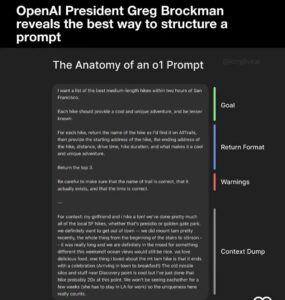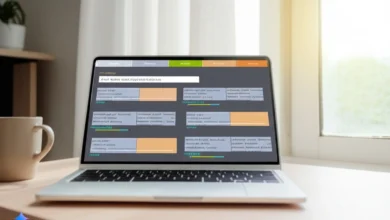
This post, titled “The Anatomy of an o1 Prompt”, breaks down on how to structure an effective prompt based on a format shared by Greg Brockman, President of OpenAI.

It’s a simple visual guide showing the ideal components of a well-structured prompt, which helps get accurate, personalized, and high-quality outputs from AI systems like ChatGPT.
Let’s go through the prompt, suggested by Brockman, section by section.
1. Goal
“I want a list of the best medium-length hikes within two hours of San Francisco.”
Explanation: This is the core request. It clearly states:
- What the user wants: a list of hikes
- Specific criteria: medium-length
- Location-based filter: within two hours of San Francisco
This helps the AI understand the intent and scope.
2. Return Format
“Each hike should provide a cool and unique adventure, and be lesser known.”
“For each hike, return the name… starting address… ending address… distance, drive time, hike duration, what makes it unique.”
“Return the top 3.”
Explanation: This tells the AI exactly what information to include and how to format the response:
- Specific fields: name, addresses, distance, drive time, hike duration, uniqueness
- A quantity limit: top 3 hikes
- A subtle qualitative filter: lesser-known and unique
This prevents vague answers by giving structure and expected data points.
3. Warnings
“Be careful to make sure that the name of trail is correct, that it actually exists, and that the time is correct.”
Explanation: This is a quality control request. You’re asking the AI to verify:
- Accuracy of trail names
- Existence of trails
- Correctness of time and logistical data
This step reduces hallucinations (AI making things up) and encourages factual correctness.
4. Context Dump
“For context: my girlfriend and I hike a ton!…”
Explanation: This is background information, giving the AI more context about:
- Your preferences (you like unique, ocean-view hikes)
- Hikes you’ve already done (e.g., Mount Tam, Discovery Point)
- Your situation (celebration weekend, travel distance, no repeats)
This personalizes the response. It helps the AI filter out suggestions you’ve already done or wouldn’t enjoy.
Why This Prompt Is Effective:
- Goal: Tells the AI what to do
- Return Format: Sets expectations for structure
- Warnings: Flags potential errors to avoid
- Context Dump: Adds personalization and nuance
Evolved, Prompt Template for o1 :
We are adding a reusable Prompt Structuring Template based on the “Anatomy of an o1 Prompt” shared by Greg Brockman.
You can use this format for almost any task, travel, content writing, idea generation, product research, etc.
Final o1 Prompt Template:
🎯 GOAL: I want [clear, specific outcome]. Include any filters or constraints such as [location, time frame, budget, category, etc.]. 📦 RETURN FORMAT: For each [item/result], return: - [Field 1: e.g., name, title, etc.] - [Field 2: e.g., location, description, category] - [Field 3: e.g., benefit, score, why it's special] Limit the result to [X number] items. List items in [descending/ascending/random/alphabetical] order. ⚠️ WARNINGS: Make sure that: - [Check 1: e.g., items are real and exist] - [Check 2: e.g., no duplicates or previously done] - [Check 3: e.g., data is up-to-date or verified] Avoid [specific unwanted criteria]. 📄 CONTEXT DUMP: For context: [personal or task-specific background]. We [preferences, history, constraints, previous attempts]. We’re looking for [unique angle, surprise factor, emotional goal].
Example Input: Product Idea Generator
🎯 GOAL: I want a list of 5 creative digital product ideas in the education space that can be built in under 30 days. 📦 RETURN FORMAT: For each idea, return: - Name - What it does - Target user - Monetization method - Tools or platforms needed List them from most scalable to most niche. ⚠️ WARNINGS: Ensure the ideas are realistic, not generic, and not already saturated in the market. 📄 CONTEXT DUMP: For context: I run a small solo edu-tech blog and want to launch a microproduct. I’ve already done eBooks and Notion templates. I have some technical skill but prefer no-code tools.
✍️ Final Thoughts
This format is powerful because it balances:
- Precision (in structure)
- Clarity (in language)
- Personalization (in background info)
You can use this approach to structure prompts for:
- Travel planning
- Business research
- Personal recommendations
- Technical tasks
- Creative writing
- And more
Please visit our highly curated and tested prompts.
If you have an idea or desire a custom prompt, do let us know in contact us form. It’s a free service for our esteemed readers.






